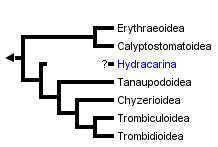Parasitengona
Velvet mites, chiggers, water mites
Heather Proctor


This tree diagram shows the relationships between several groups of organisms.
The root of the current tree connects the organisms featured in this tree to their containing group and the rest of the Tree of Life. The basal branching point in the tree represents the ancestor of the other groups in the tree. This ancestor diversified over time into several descendent subgroups, which are represented as internal nodes and terminal taxa to the right.

You can click on the root to travel down the Tree of Life all the way to the root of all Life, and you can click on the names of descendent subgroups to travel up the Tree of Life all the way to individual species.
For more information on ToL tree formatting, please see Interpreting the Tree or Classification. To learn more about phylogenetic trees, please visit our Phylogenetic Biology pages.
close boxIntroduction
The Cohort Parasitengona comprises 6 superfamilies of terrestrial prostigmatan mites and 9 superfamilies of aquatic mites (this group being termed the Hydracarina or water mites) for a total of about 60 families. There are about 7000 named species, 5000 of which belong to the Hydracarina (Welbourn 1991). Many of the named terrestrial species belong to the medically important Trombiculoidea, a group that contains the chiggers (also known as scrub itch mites).
Characteristics
The major uniting characteristic of the Parasitengona is their complex life-cycle, consisting of a parasitic larva, two inactive pupa-like stages that represent the protonymph and tritonymph, and active predatory deutonymphal and adult stages.
Life Cycle and Ecology
Parasitengone mites share a common life cycle that is complex ontogenetically and ecologically (Krantz 1978). They are termed protelean parasites because larvae are parasitic while deutonymphs and adults are predatory. Protonymphs and tritonymphs are inactive, pupa-like stages called calyptostases. Most species of parasitengones parasitize arthropods, but the Trombiculidae, Leeuwenhoekiidae, and an aberrant genus of water mites (Thermacarus) parasitize vertebrates. Amphibians, reptiles, birds and mammals are all subject to attack from these larvae. Trombiculids and leeuwenhoekiids are familiarly known as chiggers or scrub itch mites because of the itchy welts they leave after feeding. They can also transmit parasitic diseases (e.g. scrub typhus), and are thus considered medically important arthropods. Adult parasitengones feed on insect eggs, larvae and pupae as well as other small arthropods. Next to ticks, they are the largest of all mites and can reach body lengths of more than 1 cm. Adults are typically bright red and conspicuous, which together with their often furry bodies has resulted in their common name 'velvet mites'.
Discussion of Phylogenetic Relationships
Welbourn (1991) proposed the illustrated hypothesis of relationships based on a cladistic analysis of 51 genera, using primarily morphological characters of larvae. The relationship between the Hydracarina and the other parasitengones isn't clear, and some authorities consider the water mites (Hydracarina) to be the sister group to the rest of the Parasitengona (Smith & Cook 1991). This hypothesis implies that terrestrial parasitengones are derived from aquatic ones.
References
Krantz, G.W. 1978. A manual of acarology, 2nd ed. Oregon State University Book Stores, Corvallis.
Smith, I.M. and D.R. Cook. 1991. Water mites. pp. 523-592 in: J.H. Thorp and A.P. Covich (eds.) Ecology and classification of North American freshwater invertebrates. Academic Press, San Diego.
Welbourn, W.C. 1991. Phylogenetic studies of the terrestrial Parasitengona. pp. 163-170 in: F. Dusbabek and V. Bukva (eds.) Modern acarology, Vol. 2. Academia, Prague,and SPB Academic Publishing, The Hague.
Title Illustrations

Parasitengone larva parasitizing a parasitengone adult (Smarididae) from Queensland, Australia. Drawing copyright © 1998, H. Proctor.
| Copyright |
© 1998 Heather Proctor

|
|---|
About This Page
Heather Proctor

University of Alberta, Edmonton, Alberta, Canada
Correspondence regarding this page should be directed to Heather Proctor at
Page copyright © 1998 Heather Proctor
 Page: Tree of Life
Parasitengona. Velvet mites, chiggers, water mites.
Authored by
Heather Proctor.
The TEXT of this page is licensed under the
Creative Commons Attribution License - Version 3.0. Note that images and other media
featured on this page are each governed by their own license, and they may or may not be available
for reuse. Click on an image or a media link to access the media data window, which provides the
relevant licensing information. For the general terms and conditions of ToL material reuse and
redistribution, please see the Tree of Life Copyright
Policies.
Page: Tree of Life
Parasitengona. Velvet mites, chiggers, water mites.
Authored by
Heather Proctor.
The TEXT of this page is licensed under the
Creative Commons Attribution License - Version 3.0. Note that images and other media
featured on this page are each governed by their own license, and they may or may not be available
for reuse. Click on an image or a media link to access the media data window, which provides the
relevant licensing information. For the general terms and conditions of ToL material reuse and
redistribution, please see the Tree of Life Copyright
Policies.
- First online 12 August 1998
- Content changed 09 August 1998
Citing this page:
Proctor, Heather. 1998. Parasitengona. Velvet mites, chiggers, water mites. Version 09 August 1998. http://tolweb.org/Parasitengona/2581/1998.08.09 in The Tree of Life Web Project, http://tolweb.org/








 Go to quick links
Go to quick search
Go to navigation for this section of the ToL site
Go to detailed links for the ToL site
Go to quick links
Go to quick search
Go to navigation for this section of the ToL site
Go to detailed links for the ToL site